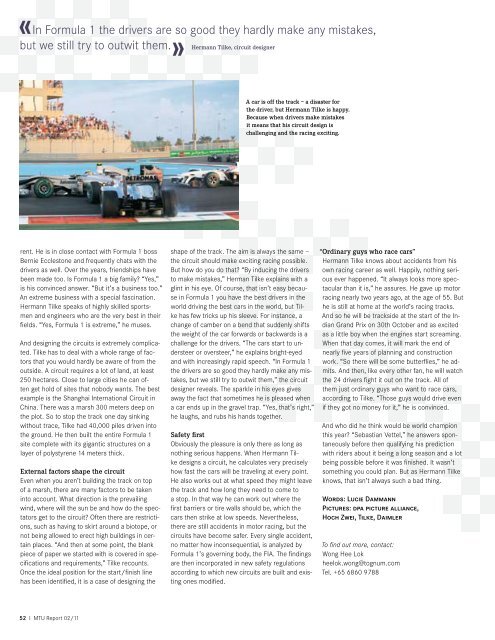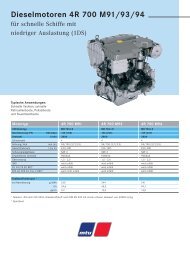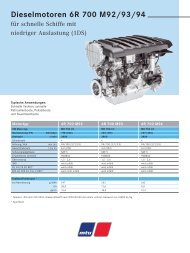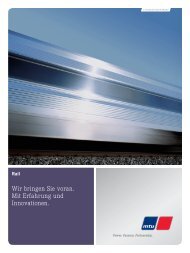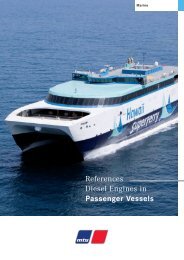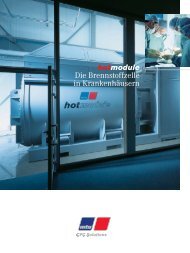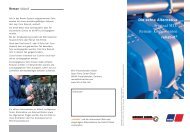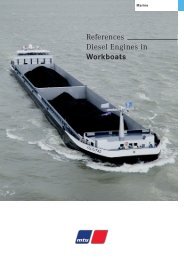You also want an ePaper? Increase the reach of your titles
YUMPU automatically turns print PDFs into web optimized ePapers that Google loves.
«In Formula 1 the drivers are so good they hardly make any mistakes,<br />
but we still try to outwit them.» Hermann Tilke, circuit designer<br />
rent. He is in close contact with Formula 1 boss<br />
Bernie Ecclestone and frequently chats with the<br />
drivers as well. Over the years, friendships have<br />
been made too. Is Formula 1 a big family? “Yes,”<br />
is his convinced answer. “But it’s a business too.”<br />
An extreme business with a special fascination.<br />
Hermann Tilke speaks <strong>of</strong> highly skilled sportsmen<br />
and engineers who are the very best in their<br />
fields. “Yes, Formula 1 is extreme,” he muses.<br />
And designing the circuits is extremely complicated.<br />
Tilke has to deal with a whole range <strong>of</strong> factors<br />
that you would hardly be aware <strong>of</strong> from the<br />
outside. A circuit requires a lot <strong>of</strong> land, at least<br />
250 hectares. Close to large cities he can <strong>of</strong>-<br />
t en get hold <strong>of</strong> sites that nobody wants. The best<br />
example is the Shanghai International Circuit in<br />
China. There was a marsh 300 meters deep on<br />
the plot. So to stop the track one day sinking<br />
without trace, Tilke had 40,000 piles driven into<br />
the ground. He then built the entire Formula 1<br />
site complete with its gigantic structures on a<br />
layer <strong>of</strong> polystyrene 14 meters thick.<br />
External factors shape the circuit<br />
Even when you aren’t building the track on top<br />
<strong>of</strong> a marsh, there are many factors to be taken<br />
into account. What direction is the prevailing<br />
wind, where will the sun be and how do the spectators<br />
get to the circuit? Often there are restrictions,<br />
such as having to skirt around a biotope, or<br />
not being allowed to erect high buildings in certain<br />
places. “And then at some point, the blank<br />
piece <strong>of</strong> paper we started with is covered in specifications<br />
and requirements,” Tilke recounts.<br />
Once the ideal position for the start/finish line<br />
has been identified, it is a case <strong>of</strong> designing the<br />
52 I <strong>MTU</strong> Report 02/11<br />
A car is <strong>of</strong>f the track – a disaster for<br />
the driver, but Hermann Tilke is happy.<br />
Because when drivers make mistakes<br />
it means that his circuit design is<br />
challenging and the racing exciting.<br />
shape <strong>of</strong> the track. The aim is always the same –<br />
the circuit should make exciting racing possible.<br />
But how do you do that? “By inducing the drivers<br />
to make mistakes,” Herman Tilke explains with a<br />
glint in his eye. Of course, that isn’t easy because<br />
in Formula 1 you have the best drivers in the<br />
world driving the best cars in the world, but Tilke<br />
has few tricks up his sleeve. For instance, a<br />
change <strong>of</strong> camber on a bend that suddenly shifts<br />
the weight <strong>of</strong> the car forwards or backwards is a<br />
challenge for the drivers. “The cars start to understeer<br />
or oversteer,” he explains bright-eyed<br />
and with increasingly rapid speech. “In Formula 1<br />
the drivers are so good they hardly make any mistakes,<br />
but we still try to outwit them,” the circuit<br />
designer reveals. The sparkle in his eyes gives<br />
away the fact that sometimes he is pleased when<br />
a car ends up in the gravel trap. “Yes, that’s right,”<br />
he laughs, and rubs his hands together.<br />
Safety first<br />
Obviously the pleasure is only there as long as<br />
nothing serious happens. When Hermann Tilke<br />
designs a circuit, he calculates very precisely<br />
how fast the cars will be traveling at every point.<br />
He also works out at what speed they might leave<br />
the track and how long they need to come to<br />
a stop. In that way he can work out where the<br />
first barriers or tire walls should be, which the<br />
cars then strike at low speeds. Nevertheless,<br />
there are still accidents in motor racing, but the<br />
circuits have become safer. Every single accident,<br />
no matter how inconsequential, is analyzed by<br />
Formula 1’s governing body, the FIA. The findings<br />
are then incorporated in new safety regulations<br />
according to which new circuits are built and existing<br />
ones modified.<br />
“Ordinary guys who race cars”<br />
Hermann Tilke knows about accidents from his<br />
own racing career as well. Happily, nothing serious<br />
ever happened. “It always looks more spectacular<br />
than it is,” he assures. He gave up motor<br />
racing nearly two years ago, at the age <strong>of</strong> 55. But<br />
he is still at home at the world’s racing tracks.<br />
And so he will be trackside at the start <strong>of</strong> the Indian<br />
Grand Prix on 30th October and as excited<br />
as a little boy when the engines start screaming.<br />
When that day comes, it will mark the end <strong>of</strong><br />
nearly five years <strong>of</strong> planning and construction<br />
work. “So there will be some butterflies,” he admits.<br />
And then, like every other fan, he will watch<br />
the 24 drivers fight it out on the track. All <strong>of</strong><br />
them just ordinary guys who want to race cars,<br />
according to Tilke. “Those guys would drive even<br />
if they got no money for it,” he is convinced.<br />
And who did he think would be world champion<br />
this year? “Sebastian Vettel,” he answers spontaneously<br />
before then qualifying his prediction<br />
with riders about it being a long season and a lot<br />
being possible before it was finished. It wasn’t<br />
something you could plan. But as Hermann Tilke<br />
knows, that isn’t always such a bad thing.<br />
Words: Lucie Dammann<br />
Pictures: dpa picture alliance,<br />
Hoch Zwei, Tilke, Daimler<br />
To find out more, contact:<br />
Wong Hee Lok<br />
heelok.wong@tognum.com<br />
Tel. +65 6860 9788


